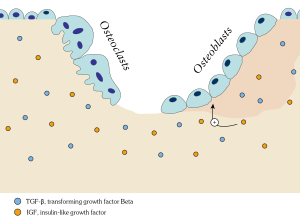This article has multiple issues. Please help improve it or discuss these issues on the talk page. (Learn how and when to remove these messages)
|

Ossification (also called osteogenesis or bone mineralization) in bone remodeling is the process of laying down new bone material by cells named osteoblasts. It is synonymous with bone tissue formation.[1] There are two processes resulting in the formation of normal, healthy bone tissue:[2] Intramembranous ossification is the direct laying down of bone into the primitive connective tissue (mesenchyme), while endochondral ossification involves cartilage as a precursor.
In fracture healing, endochondral osteogenesis is the most commonly occurring process, for example in fractures of long bones treated by plaster of Paris, whereas fractures treated by open reduction and internal fixation with metal plates, screws, pins, rods and nails may heal by intramembranous osteogenesis.
Heterotopic ossification is a process resulting in the formation of bone tissue that is often atypical, at an extraskeletal location. Calcification is often confused with ossification. Calcification is synonymous with the formation of calcium-based salts and crystals within cells and tissue. It is a process that occurs during ossification, but not necessarily vice versa.
The exact mechanisms by which bone development is triggered remains unclear, but growth factors and cytokines appear to play a role.
| Time period[3] | Bones affected[3] |
|---|---|
| Third month of fetal development | Ossification in long bones beginning |
| Fourth month | Most primary ossification centers have appeared in the diaphyses of bone. |
| Birth to 5 years | Secondary ossification centers appear in the epiphyses |
| 5 years to 12 years in females, 5 to 14 years in males | Ossification is spreading rapidly from the ossification centers and various bones are becoming ossified. |
| 17 to 20 years | Bone of upper limbs and scapulae becoming completely ossified |
| 18 to 23 years | Bone of the lower limbs and os coxae become completely ossified |
| 23 to 26 years | Bone of the sternum, clavicles, and vertebrae become completely ossified |
| By 25 years | Nearly all bones are completely ossified |
- ^ "bone formation | Definition & Physiology". Encyclopedia Britannica. Retrieved 2021-01-22.
- ^ Caetano-Lopes J, Canhão H, Fonseca JE (2007). "Osteoblasts and bone formation". Acta reumatológica portuguesa. 32 (2): 103–10. PMID 17572649.
- ^ a b Emily Morey-Holton. "Predicting Height from the Length of Limb Bones". Examining Effects of Space Flight on the Skeletal System. Moffett Field, California: NASA Ames Research Center. Archived from the original on 2012-03-01.